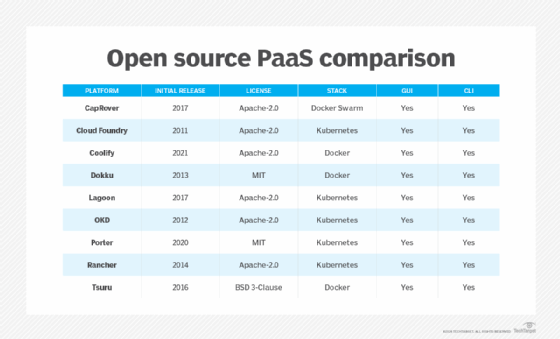Cloud Foundry
What is Cloud Foundry?
Cloud Foundry is an Open Source cloud platform as a service (PaaS) on which developers can build, deploy, run and scale applications. VMware created Cloud Foundry, which is now part of Pivotal Software, whose parent company is Dell Technologies.
Cloud Foundry is licensed under Apache 2.0 and supports Java, Node.js, Go, PHP, Python, Ruby, .NET Core and Staticfile. The open source PaaS is highly customizable, allowing developers to code in multiple languages and frameworks. This eliminates the potential for vendor lock-in, a common concern with PaaS. Cloud Foundry is also available from multiple vendors, in addition to being an open source product.

Developers choose Cloud Foundry because it's free, open source and allows them to use their own tools and code. Organizations can deploy Cloud Foundry PaaS on their internal infrastructure; on cloud providers' infrastructure, such as Amazon Web Services (AWS) or OpenStack; or on Cloud Foundry-certified platforms, including IBM Bluemix Cloud Foundry,
Pivotal Cloud Foundry, SAP Cloud Platform, Huawei FusionStage and Swisscom Application Cloud.
Similar platforms and competitors to Cloud Foundry include OpenShift, Google App Engine and Heroku.
What are Cloud Foundry components?
According to the Cloud Foundry Foundation, the Cloud Foundry platform consists of seven core groups of components, including the following:
- Routing. Directs traffic coming into the Cloud Foundry platform to the appropriate component.
- Authentication. Contains an OAuth2 and login server for user identity management.
- Application lifecycle. Provides application deployment and management services. It includes the Cloud Controller, a service that pushes or deploys an application to Cloud Foundry; pieces of Cloud Foundry's Diego architecture for the management of containerized applications; and nsync, which monitors the state of an application.
- Application storage and execution. Contains a Blobstore repository for large files, as well as Diego Cell, another component of the Diego architecture. Every virtual machine (VM) has a Diego Cell that manages when an application starts and stops, as well as the VM's containers.
- Service brokers. Helps link applications to certain services, such as databases.
- Messaging. Provides the ability for VMs to communicate through HTTP or HTTPS protocols. It includes the Consul server, which stores long-term control data like component IP addresses, as well as the Bulletin Board System (BBS), which stores data that is updated frequently, such as application status.
- Metrics and logging. Provides Loggregator, which streams application logs to developers, and the Metrics Collector, which provides data to help organizations monitor their Cloud Foundry environment.

Building a Cloud Foundry app
Once Cloud Foundry has been launched in the designated cloud service, opening the CLI (command-line interface) for Cloud Foundry initiates the process for building an app. A buildpack framework provides a structure for compiling and launching the app.
Buildpacks secure the necessary APIs, libraries, automation tools, runtime tools and other resources, such as BOSH automation framework and GitHub to support the development process. The application development process generates containers into which the app is deployed.
Garden is the runtime tool for managing container apps in Cloud Foundry. An orchestration tool such as Kubernetes can be added to the process to create the container contents.
The history of Cloud Foundry
In 2009, VMware engineers Mark Lucovsky, Derek Collison and Vadim Spivak led the team that designed and architected the Cloud Foundry platform, which was launched in April 2011. VMware called the platform the industry's first open source PaaS.
In 2012, VMware and its parent company EMC announced plans to spin off parts of their cloud and software business -- including Cloud Foundry -- into a new business called Pivotal Software.
In 2016, Dell Technologies acquired EMC, including its VMware and Pivotal businesses.
However, in 2019, VMware acquired Pivotal with Dell Technologies remaining a majority stockholder of VMware. That move was followed by the completed spinoff of Dell's equity ownership in VMware in November 2021 and the 2022 announcement of VMware's acquisition by chipmaker Broadcom.
The new date for the merger to be complete is May 26, 2023.
Cloud Foundry Foundation members
In February 2014, Pivotal announced its intention to establish an open governance model for the Cloud Foundry platform, as well as create a nonprofit foundation dedicated to advancing the Cloud Foundry technology and its vendor ecosystem.
The Cloud Foundry Foundation, launched in 2015, has more than 50 members.
Benefits of using Cloud Foundry
In addition to being an open source PaaS product, Cloud Foundry provides all the tools and resources needed to build cloud-based applications and containers. It offers tutorials and a Cloud Foundry Certified Developer certification for those who work regularly with Cloud Foundry.
The costs for application and container development can be greatly reduced using Cloud Foundry. It has its own native workflow, which differs from other PaaS products, such as Kubernetes, which is more flexible and adaptable to user workflow requirements.
Many cloud vendors, such as AWS, Microsoft Azure and Google Cloud offer Cloud Foundry in their service catalogs.
Limitations of Cloud Foundry
The basic premise of Cloud Foundry is to facilitate the development of cloud applications as well as container-based applications. As noted earlier, its workflow is fairly strict and less flexible than other development platforms.
It may also be useful to review Cloud Foundry deployments offered by third-party firms and cloud service providers to identify any variations in code and instructions.
Users who wish to avoid vendor lock-in should consider using the open source version instead.
Compare Red Hat OpenShift vs. Cloud Foundry in a Kubernetes faceoff.




